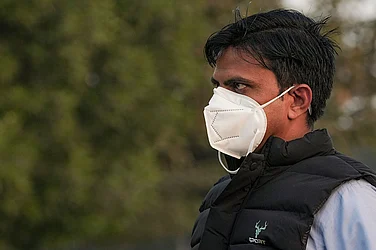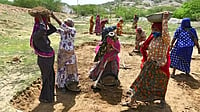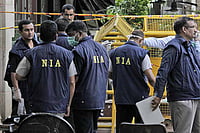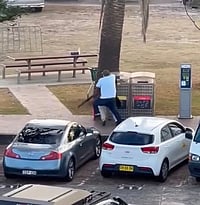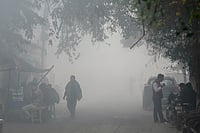"The ship of state, Bernard, is the only ship that leaks from the top."
—Sir Humphrey in Bed of Nails (Yes, Minister)
Two days after former foreign minister Jaswant Singh alleged that a mole in then prime minister P.V. Narasimha Rao's office leaked nuclear secrets to the United States, Prime Minister Manmohan Singh literally walked into a soundbite ambush. Returning from a lunch hosted by the Lok Sabha Speaker at the Parliament annexe, Manmohan was asked about the mole issue by TV reporters. Unprepared, he answered, "If he (Jaswant Singh) has the decency and courage, he should name the person he is accusing of being a mole. We are not afraid of any debate on any issue."
"Decency" and "courage" are two qualities Jaswant prides himself on—and their mention promptly drew blood. Jaswant's riposte to a TV channel was, "I'm actually not given to indecent exposure and he (the PM) does not have to challenge me. I will seek a time with him. I will go and give him the document that I have." (The document in question is a letter an American diplomat wrote to a senator in 1995; it came into Jaswant's possession a decade ago in as-yet unexplained circumstances.)
But the former foreign minister refused to divulge the name of the alleged mole. "I won't make public the name because there is a national purpose behind it." In effect, Jaswant shifted the political onus to clarify the matter to the nation's satisfaction on the prime minister. The issue was a decade-old, one that Jaswant didn't think important enough to bring to focus earlier. Is he now making a mountain out of a molehill?
Yet, the media went into a mole-hunt frenzy. Two names did the rounds. One was of A.N. Verma, a principal secretary to Rao, now dead. The media scrutiny also focused on V.S. Arunachalam, a recipient of the Padma Vibhushan, the nation's highest civilian award, and a distinguished scientist whose services to the country's scientific development are awesome. The confusion over the mole was further compounded by Jaswant's contradictory statements and characteristic evasiveness, including a statement declaring that accusations against Arunachalam were "baseless".
Those in the intelligence community say Jaswant's claim is untenable. For, other than a handler, the only other person who typically knows the name of the asset being cultivated is the particular agency's head. Consequently, they say, sundry diplomats can't possibly spell out the names of sources in the intelligence realm to sundry senators.
Other sources who worked closely on Narasimha Rao's bid to test two weapons find it outrageous that a man like Arunachalam could be accused of being a "mole". They say he pioneered the indigenisation of the MiG aircraft breakpads as director, Defence Metallurgical Research Limited, Hyderabad. He served as head ofDRDO for six years, thereafter providing corporate guidance on and leadership to projects like the Light Combat Aircraft, electronic warfare and hi-speed computers.
Reconstructing the events of 1995, these sources say that mid-year Rao had ordered a comprehensive impact analysis of the political/economic/strategic aspects of the decision to resume nuclear testing. About 50 pages in length, the study said the neighbourhood had become rowdy in the nuclear sense because of Pakistan's nuclear sabre-rattling, the US administration's dalliance with General Zia after the invasion of Afghanistan, and the Sino-Pakistan collaboration on the manufacture of nuclear triggers. It said national security would be deeply affected if India did not conduct a nuclear test and that the nuclear asymmetry with Pakistan would increase. It left the exercise of the nuclear option to the prime minister. The study went through a couple of more revisions, with the economic input disfavouring the tests. By September, the study was finalised.
Meanwhile, a series of meetings began on the issue. Most of the meetings were in Delhi, although some in the later part of the year were held in Gujarat. In 1992, though Arunachalam was on a sabbatical to the US, he had been allowed to retain his house in Delhi's Lodhi Estate and continued to function as a consultant to Rao, to whom he had direct access even then. He was present, say sources, at the time the study was discussed. Sources in Mumbai say members in the team of R. Chidambaram, then head of the Atomic Energy Commission, were surprised by Arunachalam's opposition to the test. Arunachalam argued that the test would bring economic ruination as also put the skids under the trade in high technology.
By then, site activities had begun, following Rao's nod to prepare to test two nuclear weapons in 10 days' time once the final signal was given (called D-10). Consequently, concrete seals on two shafts dug in '80-81 were blown off, and the water that had collected in them pumped out. Prefab Nissen huts were set up as part of the infrastructure to monitor the tests. On December 15, The New York Times reported that satellites had picked up activities in Pokhran.
Soon after, say sources familiar with the sequence of events, then US ambassador to Delhi, Frank Wisner, visited the PMO with the satellite pictures. Rao was on the backfoot. A call was made to the scientists at the site (some of whom were in the shafts): "Stand down."
Rao had backed out, even though the majority of the people involved in the exercise favoured conducting the test.








